 Sun on Sunday for a change! And some spaniels and a bouvier were waiting for us when we arrived at the start of the Elsie's Peak walk,
Sun on Sunday for a change! And some spaniels and a bouvier were waiting for us when we arrived at the start of the Elsie's Peak walk,  but the spaniels soon left - and there they go with Omie Domes (their human) past the piles of quarried stone that is left over from when Elsie's Peak was a quarry for building stone and road gravel. We think the walls and ruins at the start of the walk on Mountain Road must have something to do with the quarry works. Sue and Thea soon joined us after taking the wrong road thanks to the Food Lady's incorrect instructions!
but the spaniels soon left - and there they go with Omie Domes (their human) past the piles of quarried stone that is left over from when Elsie's Peak was a quarry for building stone and road gravel. We think the walls and ruins at the start of the walk on Mountain Road must have something to do with the quarry works. Sue and Thea soon joined us after taking the wrong road thanks to the Food Lady's incorrect instructions!  An unconcerned Cape Grassbird. They have recently changed family (which is what I would like to do too sometimes) thanks to molecular research on their genes. They used to be part of the warbler family Sylviidae (larks and swallows) but now have their own family, the African Warblers (Macrosphenidae) which only share a distant relative with the Sylviidae.
An unconcerned Cape Grassbird. They have recently changed family (which is what I would like to do too sometimes) thanks to molecular research on their genes. They used to be part of the warbler family Sylviidae (larks and swallows) but now have their own family, the African Warblers (Macrosphenidae) which only share a distant relative with the Sylviidae. There were lots of these little plants growing in the damp sand of the path, and when you open them up ...
There were lots of these little plants growing in the damp sand of the path, and when you open them up ...  they look like this. Men-in-a-boat (Colchicum eucomoides).
they look like this. Men-in-a-boat (Colchicum eucomoides).  We walked across to the other side of the mountain with lovely views over Glencairn and Simons Town.
We walked across to the other side of the mountain with lovely views over Glencairn and Simons Town. Then Alice and the Food Lady saw an interesting plant - the rare (on the Red List) False Heath (Audouinia capitata), which is only known from about 15 localities on the Peninsula and near Hermanus. It is member of the Brunia family (Bruniaceae) but masquerades as an erica. It is a resprouter – which means it needs fire in order to maintain a healthy population. According to Tony Rebelo, most resprouters thrive in the two to five years after a fire and then die down - so that in 10-year old veld they are often leggy and half dead. On the other hand many of these fynbos resprouters are astonishingly old - as much as 300-800 years old! Every fire prunes and revitalizes them, so although they are very old they don’t look their age (in young veld that is). For more interesting facts on fynbos resprouters and Andouinia click here.
Then Alice and the Food Lady saw an interesting plant - the rare (on the Red List) False Heath (Audouinia capitata), which is only known from about 15 localities on the Peninsula and near Hermanus. It is member of the Brunia family (Bruniaceae) but masquerades as an erica. It is a resprouter – which means it needs fire in order to maintain a healthy population. According to Tony Rebelo, most resprouters thrive in the two to five years after a fire and then die down - so that in 10-year old veld they are often leggy and half dead. On the other hand many of these fynbos resprouters are astonishingly old - as much as 300-800 years old! Every fire prunes and revitalizes them, so although they are very old they don’t look their age (in young veld that is). For more interesting facts on fynbos resprouters and Andouinia click here.  And look how patiently Maddy is sitting while all this is being explained! I, on the other hand had left long ago with the Alph, and we had discovered some ...
And look how patiently Maddy is sitting while all this is being explained! I, on the other hand had left long ago with the Alph, and we had discovered some ... BABOONS!
BABOONS!  But before we could get at them, the Alph clapped us in leads. Spoilsport.
But before we could get at them, the Alph clapped us in leads. Spoilsport. So all we could do was watch - and quiver a bit. Just you keep watching out baboon! Shirley Strum is strumming up support to have you lot chased FAR away where you belong.
So all we could do was watch - and quiver a bit. Just you keep watching out baboon! Shirley Strum is strumming up support to have you lot chased FAR away where you belong. While we fantasized about chasing baboons all the way to Cape Point, the Food Lady and the others carried on botanising. This is a Granny Bonnet/Moederkappie (Disperis capensis var. capensis) that is also sometimes called a Cape Witch Orchid.
While we fantasized about chasing baboons all the way to Cape Point, the Food Lady and the others carried on botanising. This is a Granny Bonnet/Moederkappie (Disperis capensis var. capensis) that is also sometimes called a Cape Witch Orchid. A pretty blue Pyjamabush or Agtdaegeneesbos (Lobostemon fruticosus). A member of the Forget-me-not family, Boraginaceae.
A pretty blue Pyjamabush or Agtdaegeneesbos (Lobostemon fruticosus). A member of the Forget-me-not family, Boraginaceae. Teatime! With shaved kudu carpaccio (we dogs only got a faint whiff of this most delicious offering from Thea), Sue hiking biscuits (ditto), same old same old rusks (a tiny crumb), and same old same old beanos (two each). Maddy, Alice, Sue, the Alph with me still on the lead because of baboon smells, and Thea. FL taking the photo, and Dougal deep in a rodent hunt somewhere.
Teatime! With shaved kudu carpaccio (we dogs only got a faint whiff of this most delicious offering from Thea), Sue hiking biscuits (ditto), same old same old rusks (a tiny crumb), and same old same old beanos (two each). Maddy, Alice, Sue, the Alph with me still on the lead because of baboon smells, and Thea. FL taking the photo, and Dougal deep in a rodent hunt somewhere. Beautiful pink and silver Amphithalea ericifolia - a member of the fabulous Fabaceae. Someone on iSpot called it a Winter Pea which we think is a nice name seeing it flowers in winter.
Beautiful pink and silver Amphithalea ericifolia - a member of the fabulous Fabaceae. Someone on iSpot called it a Winter Pea which we think is a nice name seeing it flowers in winter. We saw this sign so knew we were on the right track to the trig beacon at the other end of Brakkloofrant.
We saw this sign so knew we were on the right track to the trig beacon at the other end of Brakkloofrant. Cup Fungus (Peziza) in the sandy path. These grow on rotting wood or dung.
Cup Fungus (Peziza) in the sandy path. These grow on rotting wood or dung. Alice admiring a snake thistle bush Cullumia setosa growing on the sand dunes.
Alice admiring a snake thistle bush Cullumia setosa growing on the sand dunes. Help needed over this rocky bit please.
Help needed over this rocky bit please. Turning round to look back over Elsie's Peak and False Bay. Nearly at the end of Brakkloofrant now. It seems to be mainly sand dune, and we wish we had a geologist with us.
Turning round to look back over Elsie's Peak and False Bay. Nearly at the end of Brakkloofrant now. It seems to be mainly sand dune, and we wish we had a geologist with us. A dainty little Weeskindertjie probably Nemesia versicolor in the sand.
A dainty little Weeskindertjie probably Nemesia versicolor in the sand. The Alph and me on the top! The chap on the left got cross because he thought the Alph was taking a swipe at his dog with THAT stick, but in actual fact, he was taking a swipe at Dougal who was trying to sink his teeth into the other dog.
The Alph and me on the top! The chap on the left got cross because he thought the Alph was taking a swipe at his dog with THAT stick, but in actual fact, he was taking a swipe at Dougal who was trying to sink his teeth into the other dog. The Alph with Thea at the trig beacon.
The Alph with Thea at the trig beacon. View over Sun Valley.
View over Sun Valley. All this and heaven too!
All this and heaven too! Dougal surveying the suburb where he was born. Noordhoek in the far distance.
Dougal surveying the suburb where he was born. Noordhoek in the far distance. This kid decided to try and fix the broken trig beacon.
This kid decided to try and fix the broken trig beacon. One last flower photo on the way back - Manulea cheiranthus.
One last flower photo on the way back - Manulea cheiranthus. Then almost at the end of the walk we saw a tortoise! It was legging it across the path and disappeared into the undergrowth. Phew - quite an exciting walk.
Then almost at the end of the walk we saw a tortoise! It was legging it across the path and disappeared into the undergrowth. Phew - quite an exciting walk.Click here for a description of the route.















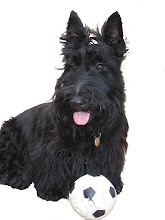










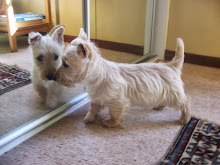



















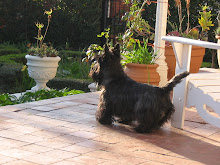






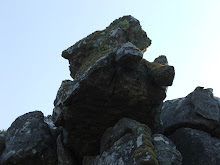





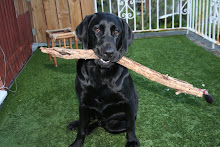





















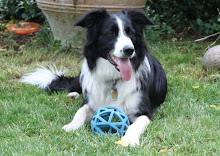

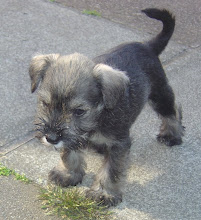













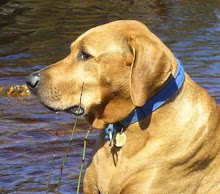




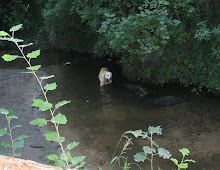



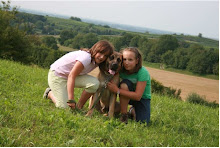

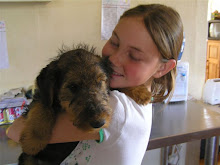








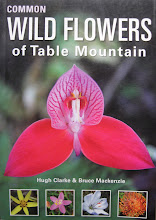


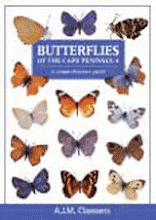






No comments:
Post a Comment